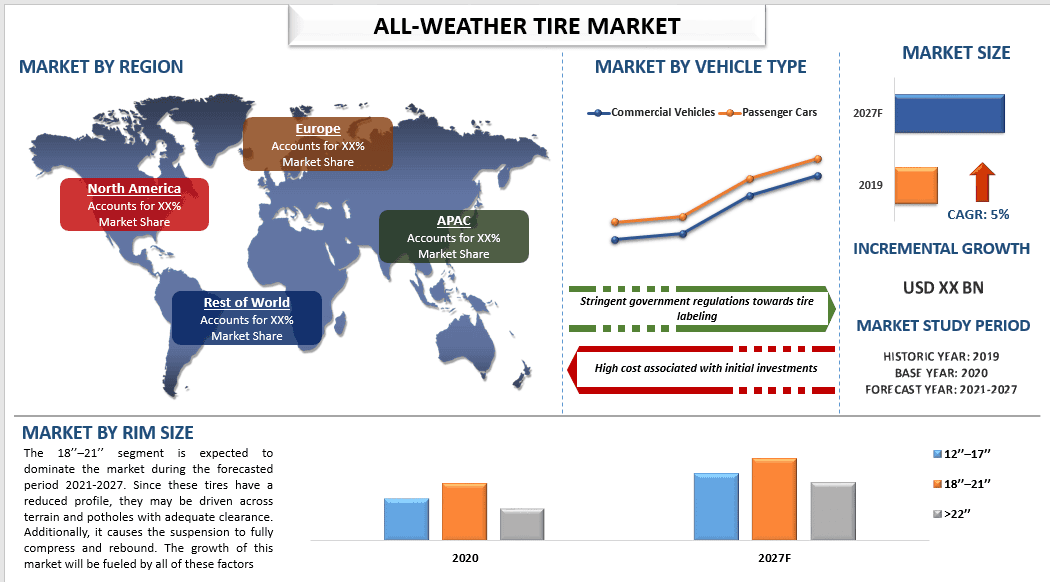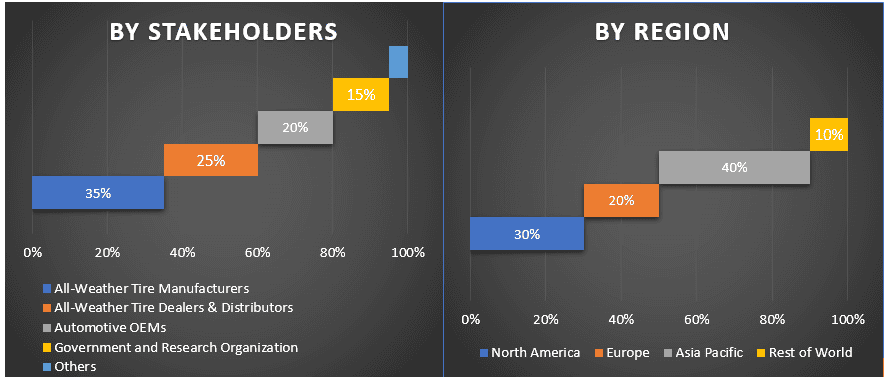- Accueil
- À propos de nous
- Industrie
- Services
- Lecture
- Contactez-nous
Marché des pneus toutes saisons : Analyse actuelle et prévisions (2021-2027)
Accent mis sur la taille de la jante (12’’–17’’, 18’’–21’’ et >22’’) ; Type de véhicule (Voitures particulières et véhicules utilitaires) ; Canal de vente (OEM et marché de la rechange) ; Région et pays

DEMANDER UN EXEMPLE DE PDF GRATUIT
Le marché mondial des pneus toutes saisons devrait afficher un TCAC d'environ 5 % au cours de la période de prévision (2021-2027). Les pneus toutes saisons sont le type de pneus qui sont réputés pour offrir des performances respectables dans des conditions sèches, pluvieuses et enneigées. Par rapport aux pneus d'été, ces pneus ont des profondeurs de bande de roulement modérées et des compositions de caoutchouc qui prolongent la durée de vie de la bande de roulement. Ils sont conçus spécialement pour l'automobiliste typique. Afin d'améliorer l'efficacité des véhicules, de réduire les effets environnementaux négatifs des pneus conventionnels et de sensibiliser aux pneus verts, les gouvernements et autres organismes de réglementation du monde entier mettent en place et proposent des lois et des programmes d'étiquetage des pneus. Par exemple, au Japon, un système volontaire d'étiquetage des pneus pour les voitures particulières a été introduit en 2010. De même, en novembre 2011, le gouvernement sud-coréen a lancé un programme volontaire d'étiquetage des pneus pour les voitures particulières, qui a ensuite été rendu obligatoire en novembre 2012. De plus, le pays a commencé à appliquer des réglementations obligatoires d'étiquetage des pneus en novembre 2016.
Aperçus présentés dans le rapport
« Parmi les tailles de jantes, le segment 18"-21" a dominé le marché en 2020 »
En fonction de la taille de la jante, le marché est segmenté en 12"-17", 18"-21" et >22". Le segment 18"-21" devrait dominer le marché au cours de la période prévisionnelle 2021-2027. Étant donné que ces pneus ont un profil réduit, ils peuvent être conduits sur des terrains et des nids-de-poule avec un dégagement adéquat. De plus, cela provoque la compression et le rebond complets de la suspension. La croissance de ce marché sera alimentée par tous ces facteurs
« Parmi les types de véhicules, le segment du marché secondaire a dominé le marché en 2020 »
En fonction du type de véhicule, le marché est segmenté en voitures particulières et véhicules utilitaires. Le segment des voitures particulières devrait dominer le marché au cours de la période prévisionnelle. La croissance de la catégorie devrait être alimentée par des facteurs tels que l'augmentation du revenu disponible des consommateurs et l'augmentation des ventes d'automobiles particulières dans des pays comme la Chine et l'Inde
« Parmi les canaux de vente, le segment des voitures particulières a dominé le marché en 2020 »
En fonction du canal de vente, le marché est segmenté en équipement d'origine et en après-vente. Le segment après-vente devrait dominer le marché au cours de la période prévisionnelle. Les remplacements annuels de pneus effectués dans chaque pays et région sont représentés par le canal de distribution du marché secondaire dans ce cas. De plus, on prévoit que la proportion de pneus de rechange sur le marché mondial augmentera en raison de l'augmentation du nombre de distributeurs, de détaillants et de partenaires de canaux en ligne offrant des tarifs compétitifs
« La région Asie-Pacifique représente le marché le plus important. »
En 2020, la part la plus élevée du marché appartenait à la région Asie-Pacifique. Le marché devrait augmenter en raison de facteurs tels que l'augmentation des ventes de voitures particulières dans les pays aux climats rigoureux comme la Chine et l'Inde, et l'expansion des industries du marché secondaire dans la région. En raison de l'expansion rapide du secteur automobile dans des pays comme la Chine, l'Inde et le Japon, la région Asie-Pacifique abrite l'un des plus grands marchés secondaires automobiles. La consommation de pneus a augmenté dans la région en raison d'un certain nombre de facteurs, notamment une augmentation de l'activité de construction, de l'expansion industrielle et du désir de technologies économes en carburant. La région est fière de la disponibilité de nombreux fournisseurs de matières premières, des bas prix de la main-d'œuvre et des réglementations gouvernementales utiles dans des pays comme la Chine, le Japon et la Corée du Sud. L'industrie agricole devrait également avoir une demande importante de pneus toutes saisons, car ces pays y accordent beaucoup d'importance.
Raisons d'acheter ce rapport :
- L'étude comprend une analyse de la taille du marché et des prévisions validée par des experts clés authentifiés de l'industrie
- Le rapport présente un aperçu rapide de la performance globale de l'industrie en un coup d'œil
- Le rapport couvre une analyse approfondie des principaux pairs de l'industrie en mettant l'accent sur les principales données financières de l'entreprise, le portefeuille de produits, les stratégies d'expansion et les développements récents
- Examen détaillé des moteurs, des contraintes, des tendances clés et des opportunités qui prévalent dans l'industrie
- L'étude couvre de manière exhaustive le marché à travers différents segments
- Analyse approfondie de l'industrie au niveau régional et national
Options de personnalisation :
Le pneu toutes saisons mondial peut être personnalisé davantage selon les exigences ou tout autre segment de marché. De plus, UMI comprend que vous pouvez avoir vos propres besoins commerciaux, alors n'hésitez pas à communiquer avec nous pour obtenir un rapport qui correspond parfaitement à vos besoins.
Table des matières
L'utilisation de pneus toutes saisons est prévue pour des températures supérieures à 7 degrés Celsius. En raison de leur adéquation à la majorité des lieux et des saisons dans le monde, les pneus toutes saisons sont largement utilisés sur tous les types de véhicules, à l'exception des régions plus froides où ils sont remplacés par des pneus d'hiver en décembre et janvier. Les pneus d'hiver sont utilisés à la place des pneus toutes saisons pendant les mois les plus froids. De plus, les pneus toutes saisons peuvent fonctionner à des températures aussi basses que 7 degrés Celsius, de sorte que ceux qui vivent dans des climats plus froids préfèrent les pneus toutes saisons aux pneus toutes saisons afin de réduire les dépenses liées à la possession d'une voiture et d'éviter les inconvénients liés à la rotation des pneus. Le marché des pneus toutes saisons et les ventes de véhicules sont stimulés par une augmentation de la propriété automobile dans les pays en développement en raison de la demande croissante de transport et de la parité d'achat des consommateurs. Étant donné que les voitures d'occasion sont de plus en plus populaires et que les véhicules sont conservés plus longtemps, il y a une augmentation du besoin de pneus de rechange, ce qui, à son tour, stimule le marché des pneus toutes saisons. La fabrication de pneus toutes saisons prend en compte un certain nombre de variables, notamment la conception de la bande de roulement, la taille/les dimensions, le poids et la construction du pneu. La matière première ou le composé utilisé dans la création de ces pneus a un impact significatif sur leur efficacité de fonctionnement et leur fiabilité. Cependant, la croissance des produits au cours de la période de prévision est limitée par la hausse des prix des matières premières nécessaires à la production de pneus toutes saisons. Le développement de pneus efficaces avec des éléments internes et externes, tels que la température, la surface de la route, l'humidité et les matières premières, est une priorité pour les entreprises de fabrication de pneus. Les acteurs de l'industrie importent des matières premières d'autres pays pour maintenir la qualité et la fiabilité de leurs produits et élargir leur clientèle sur le marché mondial. Cependant, l'escalade des frictions commerciales a un impact significatif sur les prix des matières premières. Certains des principaux importateurs et exportateurs mondiaux sont des pays comme les États-Unis et la Chine. Le coût de certaines matières premières utilisées pour fabriquer des pneus toutes saisons a augmenté en raison de l'escalade des problèmes commerciaux entre les deux pays.
Demander plus de détails sur la méthodologie de recherche
Analyse de la taille historique du marché
Étape 1 : Étude approfondie des sources secondaires :
Une étude secondaire détaillée a été menée pour obtenir la taille historique du marché du pneu toutes saisons par le biais de sources internes à l'entreprise telles que les rapports annuels et les états financiers, les présentations de performance, les communiqués de presse, etc., et de sources externes, notamment les revues, les actualités et les articles, les publications gouvernementales, les publications des concurrents, les rapports sectoriels, la base de données tierce et d'autres publications crédibles.
Étape 2 : Segmentation du marché :
Après avoir obtenu la taille historique du marché du pneu toutes saisons, nous avons mené une analyse secondaire détaillée pour recueillir des informations et des parts de marché historiques pour différents segments et sous-segments pour les principales régions. Les principaux segments inclus dans le rapport sont la taille de la jante, le type de véhicule et le canal de vente. D'autres analyses régionales et nationales ont été menées pour évaluer l'adoption globale du pneu toutes saisons dans le contexte mondial.
Étape 3 : Analyse des facteurs :
Après avoir acquis la taille historique du marché des différents segments et sous-segments, nous avons mené une analyse des facteurs détaillée pour estimer la taille actuelle du marché. De plus, nous avons effectué une analyse des facteurs à l'aide de variables dépendantes et indépendantes telles que les incitations gouvernementales croissantes et la demande de transport écologique, etc. Les tendances historiques et leur impact d'une année sur l'autre sur la taille et la part du marché ont été analysés. Le scénario de l'offre et de la demande a également été étudié en profondeur.
Estimation et prévision de la taille actuelle du marché
Taille actuelle du marché : Sur la base des informations exploitables issues des 3 étapes ci-dessus, nous sommes arrivés à la taille actuelle du marché, aux principaux acteurs du marché et aux parts de marché des segments et de l'entreprise. Tous les pourcentages de répartition et les ventilations du marché requis ont été déterminés à l'aide de l'approche secondaire susmentionnée et ont été vérifiés par le biais d'entretiens primaires.
Estimation et prévision : Pour l'estimation et la prévision du marché, des pondérations ont été attribuées à différents facteurs, notamment les moteurs et les tendances, les contraintes et les opportunités disponibles pour les parties prenantes. Après avoir analysé ces facteurs, les techniques de prévision pertinentes, c'est-à-dire l'approche ascendante, ont été appliquées pour arriver à la prévision du marché jusqu'en 2027 pour différents segments et sous-segments dans les principales régions du monde. La méthodologie de recherche adoptée pour estimer la taille du marché comprend :
- La taille du marché de l'industrie, en termes de valeur (US$) et le taux d'adoption du pneu toutes saisons sur les principaux marchés
- Tous les pourcentages d'actions, les répartitions et les ventilations des segments et sous-segments du marché
- Les principaux acteurs du pneu toutes saisons en termes de produits proposés. De plus, les stratégies de croissance adoptées par ces acteurs pour rivaliser sur le marché en croissance rapide.
Validation de la taille et de la part du marché
Recherche primaire : Des entretiens approfondis ont été menés avec les principaux leaders d'opinion (KOL), y compris les cadres de haut niveau (CXO/VP, chef des ventes, chef du marketing, chef des opérations, chef régional, chef de pays, etc.) dans les principaux pays. Les résultats de la recherche primaire ont ensuite été résumés et une analyse statistique a été effectuée pour prouver l'hypothèse énoncée. Les contributions de la recherche primaire ont été consolidées avec les résultats secondaires, transformant ainsi l'information en informations exploitables.
Répartition des participants principaux dans différentes régions

Ingénierie du marché
La technique de triangulation des données a été utilisée pour compléter l'estimation globale du marché et pour arriver à des chiffres statistiques précis pour chaque segment et sous-segment du pneu toutes saisons. Les données ont été divisées en plusieurs segments et sous-segments après avoir étudié divers paramètres et tendances dans les domaines d'application, le type de véhicule, le composant et la région.
L'objectif principal de l'étude sur le pneu toutes saisons
Les tendances actuelles et futures du marché du pneu toutes saisons ont été identifiées dans l'étude. Les investisseurs peuvent obtenir des informations stratégiques pour fonder leur pouvoir discrétionnaire en matière d'investissements sur l'analyse qualitative et quantitative effectuée dans l'étude. Les tendances actuelles et futures du marché détermineraient l'attractivité globale du marché au niveau régional et national, offrant une plate-forme aux participants industriels pour exploiter le marché inexploité afin de bénéficier d'un avantage de premier plan. Les autres objectifs quantitatifs des études comprennent :
- Analyser la taille actuelle et prévisionnelle du marché du pneu toutes saisons en termes de valeur (US$). De plus, analyser la taille actuelle et prévisionnelle du marché des différents segments et sous-segments
- Les segments étudiés sont la taille de la jante, le type de véhicule et le canal de vente
- Analyse définie du cadre réglementaire de l'industrie mondiale du pneu toutes saisons
- Analyser la chaîne de valeur impliquée avec la présence de divers intermédiaires, ainsi qu'analyser les comportements des clients et des concurrents de l'industrie
- Analyser la taille actuelle et prévisionnelle du marché du pneu toutes saisons pour les principales régions et pays
- Les principales régions étudiées dans le rapport comprennent l'Amérique du Nord (États-Unis, Canada, reste de l'Amérique du Nord), l'Europe (Allemagne, Royaume-Uni, France, Italie et reste de l'Europe), l'Asie-Pacifique (Chine, Japon, Inde, Corée du Sud, reste de l'Asie-Pacifique) et le reste du monde
- Profils d'entreprise des acteurs du pneu toutes saisons et stratégies de croissance adoptées par eux pour se maintenir sur le marché en croissance rapide
- Analyse approfondie de l'industrie au niveau régional et national
Connexes Rapports
Les clients qui ont acheté cet article ont également acheté










